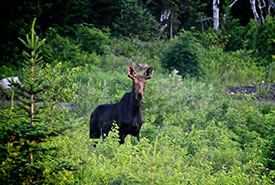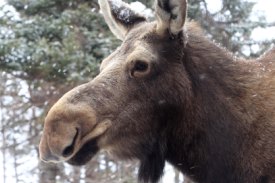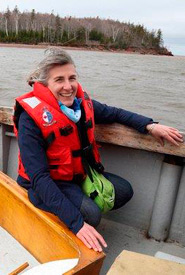Keeping my distance from a gentle giant

Moose on Mount Hereford, QC (Photo by MRC de Coaticook)
I have had a great respect for moose ever since a misadventure at Cape Breton Highlands National Park, Nova Scotia, more than 20 years ago. While hiking along the popular Skyline Trail, my boyfriend and I came across several moose grazing on low shrubs. They seemed completely unperturbed by our presence, even somewhat tame. They’re used to people, we decided.
My boyfriend suggested a picture, so I turned away from the moose closest to us and posed for the camera.
“Back up,” he suggested, and I did. “Back up a bit more, so I can get you both in the picture,” he said. I backed up a bit more.

Moose in Cookville, NB (Photo by Mike Dembeck)
Suddenly I heard a loud noise — one I’d never heard before, but which I somehow instantly knew, as I was leaping into the air in fear, was the snort of a very annoyed moose. I quickly gave the moose the space, and respect, I should have given it in the first place, by backing slowly away.
I’ve since learned that moose sometimes charge, or “fake charge,” people if they feel threatened. I was fortunate that my foolishness that time in Cape Breton didn’t threaten the moose enough that it charged. Although awkward looking, moose can run at speeds of up to 55 kilometres per hour, and when a 350- to 500-kilogram animal moves that fast, it can do some damage!
My close encounter on the Skyline Trail was with the Alces alces andersoni species of moose, which was introduced to Cape Breton Island from Alberta in the 1930s after indigenous eastern moose had been hunted to extinction. It’s fairly common to encounter these introduced moose, which are thriving in Cape Breton Highlands National Park and the surrounding area; in fact they are now considered overpopulated and in need of culling.
On mainland Nova Scotia, however, indigenous eastern moose are extremely rare, and so are encounters with them. The Nature Conservancy of Canada (NCC) conservation staff in Nova Scotia, who are on the land all summer, only occasionally see signs of them. This summer, moose footprints and scat were spotted on an NCC property in Port Joli on the South Shore. This moose was likely a member of a very small group that migrates from the province's interior to the coast to cool off during the hotter months. Unable to sweat, it's believed moose seek out the cooler breezes by the ocean in summer.
What amazes me about these gentle giants is their tenacity in the face of multiple threats. Once the most abundant large mammal in Nova Scotia, with a population estimated around 15,000 in the early 1600s, there are now about 500 moose in isolated pockets around the province. Although legal moose hunting in Nova Scotia ended in 1981, a combination of other threats, such as disease, poaching, logging and dwindling habitat, led to eastern moose being designated as endangered under the Nova Scotia Endangered Species Act in 2003.
One of the challenges for NCC when it comes to protecting moose in Nova Scotia is ensuring these reclusive vegetarians have habitat large and intact enough for their needs. Moose eat up to 27 kilograms of plants — mostly twigs — each day, so they need a large range. Their diet includes alder, willow and balsam fir as well as lichen, fireweed, lupine and water horsetail. In summer, moose require open wetlands and swamps to eat aquatic plants, such as pondweed. In winter, they need the protection of large, deep coniferous forests, both for food sources and as shelter from wind chill and snow.
The low, rolling Cobequid Mountains are one of the best remaining habitats in Nova Scotia for mainland moose. They are located along the narrow strip of forested land that connects the Nova Scotia mainland with New Brunswick and the rest of Canada. Because they are isolated from other groups, these Nova Scotia mainland moose need to meet and mate with moose from New Brunswick, where the population is more abundant. Ensuring these romances have every chance to happen is where NCC comes in: we’ve been working to conserve land and conserve a wildlife corridor between the two provinces.
Dubbed the “Moose Sex Project,” NCC is protecting this intact wilderness corridor on the Chignecto Isthmus. The hope is that NCC’s protected areas will encourage the movement of eastern moose between New Brunswick’s healthier population and Nova Scotia’s much smaller population. So far, more than 2,500 acres (1,012 hectares) have been conserved. More than just vital habitat, more than a love nest, this project is potentially a lifeline for eastern moose in Nova Scotia.
The moose is one of eight species featured in NCC’s gift giving campaign: Gifts of Canadian Nature. To learn more and to give the gift of conservation this holiday season, click here.


